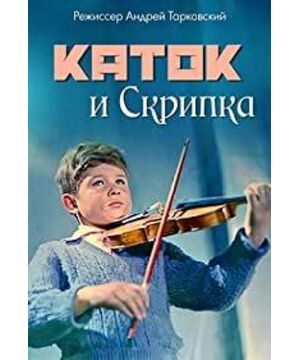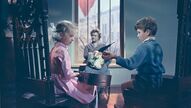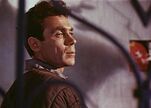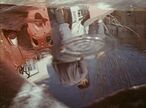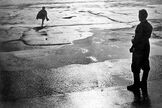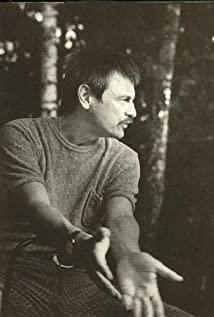I have never seen a Tarkovsky movie until today. I started my Tarkovsky cinematography marathon with his directorial debut, Roller and Violin. The film is only around 45 minutes long, but what it has accomplished in that time clearly shows the beginnings of one of the most acclaimed filmmakers of all time. Even for a student short film, the cinematography is breathtaking.
In his study of Andrei Tarkovsky's films, Peter Green remarked: "The Roller and the Violin probably wouldn't have had much significance in the history of cinema if it hadn't been made by Tarkovsky"(1). True , without Tarkovsky's international reputation, the films of his graduation work would now be eclipsed in the depths of the Russian archives, unattended, but Tarkovsky's tendency to discredit his own earlier work (most notably Is the sublime Ivanovo detstvo / Ivan's Childhood [1962] "Ivan's Childhood" [1962]") has encouraged critics and theorists to follow suit and skip the formative stages of his career. Only Maya Turovskaya ( Maya Turovskaya once objected to "Road Roller and Violin", "although it is a short film and a children's film, it deserves to be regarded as an integral part of Tarkovsky's work" (2).
Back in 1960, Andrei Tarkovsky graduated from VGIK in 1960 with a director's diploma; ( VGIK: All-Union State Film Academy, in Soviet times 'Moscow State Film Academy', Russia's leading film Abbreviation of school, hereinafter referred to as 'VGIK' ). "Road Roller and Violin" as his graduation film, completed in 1960 at the Moscow Film Studio. Before that, he had directed a 20-minute film based on Ernest Hemingway's story Ubiytsy (The Killer, 1958) and a "documentary" called Segodnya uvolneniya ne budet (will not be leaving today), It was shown on television in 1959.
Between 1959-1960, he co-wrote the script with his classmate Andrei Mikhalkov-Konchalovsky, working on the script for over six months, after which they would Write Andrei Rublov together. A Polish journalist, Mr. Zdzislaw Ornatowski, visited the Moscow Film Company to talk to some of the young and ambitious filmmakers who were working there at the time. After returning to Poland, he published an article titled "Movies for Young People: Road Rollers and Violins"[3]. In this article - apparently Andrei Tarkovsky's first media interview - Andrei says:
This will be a short film. My original thought was not to use this script for a full feature film - that would ruin the whole thing. The story in the film is very simple. The action takes place in a single day, the drama has no strong conflict and is unconventional. Its main characters are a young worker driving a road roller in road construction and a young sensitive boy who is learning to play the violin. They become friends. These two people, who are so different in every way, complement and need each other.
While it's dangerous to admit -- because people don't know if the film will be successful -- the aim is to make a poetic film. Almost everything we do is based on emotion and atmosphere. In my films, there has to be a dramatic structure of images, not literature. I offered the role of worker to Vladimir Zamyansky, the youngest and perhaps most interesting actor of the theater "Sovremennik". Little Sasha is played by seven-year-old music school student Igor Formchenko. I am very satisfied with them.
Graduation work films require a high level of attention and direction, but are also an opportunity to produce a work that showcases the director's special talents and gives him better career prospects. This resulted in a large number of studio discussion records. The transcripts of these meetings can be some fascinating reading material, as they offer unique insights into the director's personality and the issues, ideas, and tensions that arose during production. At this early stage, Tarkovsky displayed two character traits that helped define his career: ambition and arrogance.
It is clear that Tarkovsky, 28, is a principled, ambitious young man who will not compromise if there is a risk of compromising his vision. As an example of his ambition, he tried to hire the photographer Sergei zhuravli, who shot the Palme d'Or winner Letyat zhuravli / The Cranes are Flying ("The Wild Goose", 1957) for "Road Roller and Violin". Sergei Urusevsky. Apparently, Tarkovsky's idea was not just a perfunctory film school exercise, it would allow him to become a member of the Soviet film establishment. Of course, Urushevsky turned down the offer, which led to a productive collaboration between Tarkovsky and Vadim Yusov , the cameraman who directed the first three feature films.
VGIK archives reveal that the director's intention for "Road Roller and Violin" was to depict an attempt at connection between two very different worlds, art and labor , or what he calls " spirit and material ." In our opinion, one of the most rewarding moments in the film is when the boy innocently and enthusiastically pulls his violin onto a layer of asphalt, showing for the first time (perhaps for both of them) the detached power of art. The director juxtaposes the cold forms of the conservatory with the warm, exciting street life and tries to combine them in the image of the blind arch, "the arch has the meaning of a cathedral, music and human sincerity illuminated with emotion and flair. it". In "Road Roller and Violin," Tarkovsky finds beauty in music, puddles, and conversation. He even managed to find beauty in dilapidated buildings that were demolished. In the final scene, the two main characters are unable to meet, and this simple and trivial inaction feels like a tragedy. Despite its light nature and simple storytelling, "Road Roller and Fiddle" is ultimately very moving and deserves a lot of praise. It seems that from the beginning, Andrei Tarkovsky possessed a cinematic skill few others possessed. The director's fundamental belief in artistic seriousness and responsibility is articulated here.
(The young musician was criticized by his teachers for not following form and order despite playing beautifully. This insistence on beauty and creativity, rather than tradition, is what sets Tarkovsky apart from most directors One of the reasons. In hindsight, it's a fascinating similarity.)
In the final version of the film, some small scenes from Tarkovsky and Konchalovsky's original script were left out. Only two scenes have changed in some major ways, the film's ending sequence, and the sequence showing the rehearsal of the May Day parade showing tanks rolling down city streets. The latter was abandoned and replaced by a sequence of building demolition [4]. Tarkovsky was interested in creating a tragic, menacing atmosphere, a memory of the war, the explosion that Sergey - the driver of the roller - witnessed on the front lines. Instead, the noise and rumble of thunder at the demolition site reinforces this idea of war memory. All that was left of the May Day military parade was the big red flag, a solitary number "1" and a letter "M" leaning against the wall. The demolition sequence carries a sense of celebrating the new and triumphing over the old. A new city, a city full of light and shadow. Sergey was one of the builders of the city, embodying its daily life, street life and external rhythms. Interestingly, the new building that emerged from the demolition site is a prime example of the horrific socialist realist architecture that Andre absolutely hated. At first we were a little confused as to why he inserted this monster into the movie. Perhaps it can also be explained that it was indeed a last-minute substitute - he may have been forced to improvise and quickly compromised... Maybe this scene constituted "Tarkovsky's final compromise"? Of course, I'm just speculating.
"Road Roller and Violin" must be regarded as an integral part of Tarkovsky's work, because it is indeed "Tarkovsky" in every sense. Here Tarkovsky has formulated the themes, methods and ideas that he will stick to for the rest of his career. Here we see the theme of childhood, which was the rudiment of his later explorations of themes and styles. The film shows us a little girl, also a musician who learns the violin, and the boy offers her an apple, which will happen again in "Ivan's Childhood". At the end is the unforgettable dream sequence, which has a striking Tarkovsky style in its composition. From start to finish, great attention is paid to rhythm, texture, lighting (and its temporal and spatial variations), and sound, on an almost perfectionistic level.
Additionally, The Roller and the Violin is a very long short; Tarkovsky planned and shot twice as long as most graduation films at 46 minutes instead of the usual graduation film of 20 minute. Tarkovsky's penchant for long takes is already evident here. Mikhail Romm, Tarkovsky's mentor and resident defender, criticized its length, noting that some scenes lasted too long. Konchalovsky clearly remembers Tarkovsky's argument:
"If you lengthen the normal length of a shot, at first you get bored; but if you lengthen it, you become interested in it; if you lengthen it further, a new quality, a new attention Will produce."
After six months of writing the script, Tarkovsky knew exactly what he wanted on screen, and stubbornly pursued his vision. The actor himself is already in the early stages of his career and he has no particular interest in him. According to VGIK records, to the accusation of failing to make his actors — especially boys — likeable characters, he responded:
"I can't use schema language. I can't take a positive hero through a positive external reality and make people fall in love with him immediately. I don't think it's deep enough, serious enough; art isn't created that way, it's not true. This It's hacking work."
Regarding the screen test of the adult portion of the film, he would tell critics:
"The audition was poor, but as for the idea of the film, I've made it clear and I'll stick to what has been decided, otherwise we'll end up making a children's film... It's not the actors that matter, but the ideas and methods. I can't use The accepted language expresses anything."
After the film was completed, it faced mandatory screenings and discussions with Soviet film authorities. Many of them were unhappy with the "unrealistic" nature of the film and the playful quotes of Russian and European films. But Tarkovsky was stubborn—despite his nascent position, he refused to compromise, as well as euphemism and diplomacy, always defending his views on film to anyone who would listen. The move paid off. The film was approved and well received, and Tarkovsky moved from the Children's Department to the First Creative Department of the Moscow Film Company.
The film tells the straightforward story of Sasha, a young violin-playing boy who befriends an adult road roller driver, Sergey, who protects him from bullying and acts as a role model and father figure for the boy. It was the clearest statement of his frustrated desire to be perfectly aligned with the idealized father figure. Tarkovsky infuses the story with a bold visual style and intangible vibe, as well as nostalgia for the bittersweet lessons of childhood. It was much later that he was able to express his views on show business more succinctly, Tarkovsky said:
"Any idea that is not directly provided to the audience, even if processed indirectly, can be correctly perceived by the audience, will be more appreciated by the audience, because it requires the creative effort of the audience itself" [5] .
At one point in the film's story, a childhood tantrum causes Sasha to throw a loaf of bread on the ground. Turovskaya commented: "It was not many years before the end of the war, when only a precious eighth of black bread kept people alive, and people knew the moral and material value of bread". This little moment is associated with The wanton destruction of the Wrecking Ball is echoed, subtly evoking World War II. Often with Tarkovsky, the big themes and concepts seem to take place in off-screen spaces, with only slight screen traces, but make up the life of the protagonist and the film itself. Tarkovsky's own childhood experiences during the war, and his belief that films should have an autobiographical function, meant that Tarkovsky's work would never be considered "children's films."
Looking at it today, Tarkovsky's debut film resonates with some post-Soviet films. In "Road Roller and the Violin," a grown man can totally innocently invite an unrelated little boy to go to the movies with him, a clear testament to a more innocent age of public discourse. That said, it carries the pervasive sadness and rare moments of joy that make Tarkovsky's work so powerful. And, what it has accomplished during that time period clearly shows the beginnings of one of the most acclaimed filmmakers of all time. Even for a student short film, the cinematography is breathtaking. It creates an almost otherworldly atmosphere from the streets and narrow alleys of Moscow. Reflex lenses are common: from shattered glass distorting perception to a puddle in the ground shining the sun directly on the camera. Yes, The Roller and the Violin certainly heralded the coming metaphysical explosion.
I can't help but think that these reflections are symbolic of how young violinist Sasha and road roller Sergey see each other. Sasha grew up to be an artist; he had strict violin practice and study habits. Instead, Sergey was about his age when he went to war and now has to work as a road roller to make ends meet. Sasha is just as fascinated by Sergey's hard work as Sergey is by Sasha's music: You always want what you can't have. I'm really looking forward to getting on the right track with a Tarkovsky film right now.
I think in many ways it's Tarkovsky's most accessible film -- it's emotionally accessible, the plot is straightforward -- but it's also his least rewarding work.
references:
[1]. Peter Green, Andrei Tarkovsky: The Winding Quest , Palgrave Macmillan, London, 1992, p. 20.
[2]. Maya Turovskaya, Tarkovsky: Cinema as Poetry , trans. Natasha Ward, Faber and Faber, London, 1989, p. 27.
【3】 "Films of the young. The Steamroller and the Violin" ("Filmy mlodych. Walec i skrzypce"), published in the Polish magazine "Ekran" in 1961, issue 5, p. 13; excerpts presented here by Nostalghia. com for the first time in English translation.
【4】. Andrei Tarkovsky, William Powell (Translator), Natasha Synessios (Translator), Collected Screenplays, paperback - 564 pages (September 1999), Faber & Faber; ISBN: 0571142664.
【5】. Turovskaia, Maiia Iosifovna. Tarkovsky: Cinema as Poetry / Maya Turovskaya ; translated by Natasha Ward; edited and with an introduction by Ian Christie. [Rev. ed.]. London; Boston: Faber and Faber, 1989. Hardcover - 177 pages (April 1990), ISBN 0-571-14709-7.
View more about The Steamroller and the Violin reviews


